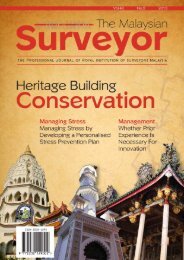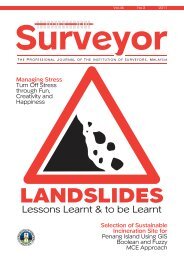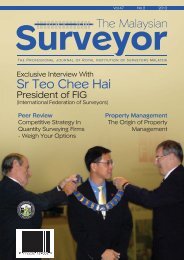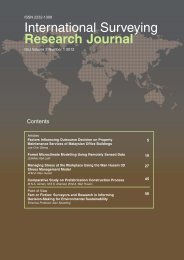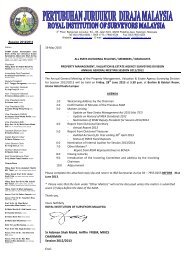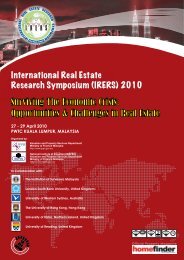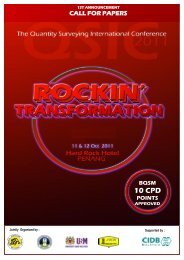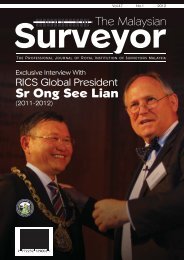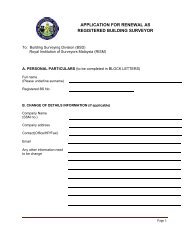Full 46.1 - Royal Institution of Surveyors Malaysia
Full 46.1 - Royal Institution of Surveyors Malaysia
Full 46.1 - Royal Institution of Surveyors Malaysia
Create successful ePaper yourself
Turn your PDF publications into a flip-book with our unique Google optimized e-Paper software.
THE MALAYSIAN SURVEYOR | Vol.46 | No.1 | 2011<br />
defects occurrence, which form an integral data<br />
to be used in determining the severity index <strong>of</strong><br />
one particular defect.<br />
3.0 The System Development<br />
Condition survey normally covers the “A to Z” <strong>of</strong><br />
a building, from structural to non-structural<br />
element. Since then, the development <strong>of</strong><br />
quantitative data for the whole building<br />
element according to types <strong>of</strong> defects is very<br />
challenging to produce. It is because when<br />
preparing the quantitative data collecting<br />
procedure, the surveyor should establish the<br />
classification <strong>of</strong> many types <strong>of</strong> data such as<br />
types <strong>of</strong> cracks, dampness in building or insect<br />
attacks, to name a few. All <strong>of</strong> the information<br />
during the field work should be coded directly<br />
in the form <strong>of</strong> numeric, or otherwise it will be a<br />
waste <strong>of</strong> time to re-code it after the field. To do<br />
this, the possible classification <strong>of</strong> defects has to<br />
be identified in the first place (to form the<br />
element <strong>of</strong> the system), as to speed-up and<br />
provide minimum interruption to the flow <strong>of</strong><br />
the condition survey work.<br />
From the survey checklist described above, the<br />
data on the latter part form integral information<br />
in developing the system. Two types <strong>of</strong> data<br />
have to be collected, namely the physical data<br />
and risk data. Physical data deals with the<br />
current condition <strong>of</strong> the building at the time <strong>of</strong><br />
the survey conducted. For risk data, it is<br />
associated with the potential hazard that might<br />
Table 2: Condition Assessment <strong>of</strong> the Building (This research, 2009)<br />
Condition Linguistic Value Average Marks<br />
Condition 1: Dilapidated Not safe for occupancy 04-09<br />
Condition 2: Fair<br />
Condition 3: Good<br />
Sign <strong>of</strong> defect in structural<br />
member (not give effect to the<br />
building stability)<br />
Need repair or replacement<br />
Main structural member is<br />
strong and stable<br />
Defects which influence<br />
aesthetic value only<br />
10-13<br />
14-17<br />
Figure 2: Data Requirement in Developing Timber Defects Prioritise Ranking System<br />
(Modified from Pitt, 1997)<br />
42



